Establishing Solar Energy Cooperatives in Ukraine: Regional Considerations and a Practical Guide
Abstract
1. Introduction
2. Literature Review
- -
- An association of persons, not capital: Members of a cooperative are individuals or legal entities that actively participate in its activities.
- -
- Democratic governance principle: Each cooperative member has one vote, regardless of the size of their contribution.
- -
- Openness to new members: The cooperative can expand without legal difficulties.
- -
- Sharing of resources: Profits are distributed not according to the size of the investment but according to each member’s level of participation.
- -
- Non-profit purpose: The main goal of a cooperative is not to maximize profits, but to provide members with quality services or goods.
2.1. Energy Cooperatives and Energy Communities as Instruments for Collective Action in Renewable Energy
2.2. Energy Cooperatives in Ukraine
- The energy system has a deficit of installed capacity.
- Households now consume more energy than industry (as opposed to before February 2022).
- There is a significant imbalance between the regions with extensive power output and regions that are power-deficient. Regions in the centre and east of Ukraine are the most energy-deficient due to the presence of energy-intensive industries there.
- Distributed energy generation is now considered a key direction in energy system development. It does not overload the existing transmission infrastructure and diminishes the losses.
3. Materials and Methods
- In this study, we employed a discount rate (r) of 15.5%, which aligns with the rate established by the National Bank of Ukraine as of July 2025 [52].
- The analysis was conducted over 25 years, which corresponds to the lifetime of a solar PV installation [53].
- The solar energy cooperative comprises 12 households, each with a 12 kW solar photovoltaic (PV) system. There is a legislative requirement that the cumulative installed capacity of energy-generating equipment of an energy cooperative should be less than 150 kW. Therefore, there can be several combinations of the number of households and their respective installed capacities. The installed capacity of 12 households, each with 12 kW of solar PV, equals 144 kW, which does not exceed the legislatively permitted 150 kW. We chose to proceed with solar PV because the equipment is relatively simple to install, readily available on the market (unlike small hydro or wind turbines), and does not require extensive permitting systems.
- For calculation purposes, each house has an area of 110 m2 (the rooftop surface affects the installed capacity of solar PV). An assumption of a household of 110 m2 was made, based on recent construction trends in Ukraine, where new family homes are generally within the range of 100–120 m2 for households of 3–4 people [54,55]. There is no official average for single-family home size; however, Ukrainian developers recommend a range that is most similar to the new housing market and falls within the same range as new homes built in the previous period. A 12 kW PV system was chosen as the most likely estimate for a Ukrainian house in this size category, considering the available roof area and feasible installation restrictions. As of 2023, in Ukraine, 74.4% of solar PV in households had an installed capacity of 30–31 kW; 2.6% had an installed capacity of above 31 kW; 7.6% had an installed capacity of 20–30 kW; 12.3% had an installed capacity of 10–20 kW; and only 3.1% had capacity below 10 kW [56]. This occurred because the FIT conditions have been very favourable (in the past), and solar PV has been used not only for self-consumption but also as a business investment. Our assumptions are intended to reflect typical homes and practical PV installation constraints rather than the official statistical average of housing stock per person (which was 24.5 m2 per capita in 2020). Additionally, the area of housing stock has changed since 2020, along with the number of people.
- The average electricity consumption is 3 kWh/m2. This is an assumption based on observations rather than official statistics because these statistics are not readily available.
- Under the net metering scheme, a cooperative is not allowed to sell more than half of the electricity generated (based on its installed capacity of RES equipment) to the grid [57].
- We utilized the PVWatts Calculator [58], created by the US National Renewable Energy Laboratory (NREL), to account for regional variations in solar potential across Ukraine. This resource calculates the energy output of solar PV installations based on average local weather and solar radiation information. To determine a region-specific capacity factor, we selected the regional centers in the PVWatts database for each region. These customized figures enabled us to estimate the annual electricity generation more precisely, rather than using an average capacity factor for the entire country.
- The FIT for solar PV Rooftop and façade in Ukraine as of 2025 is EUR-cent 12.38/kWh [44]. The FIT rates are uniform and do not differentiate across various regions of Ukraine. As of 2024, the highest number of solar PV installations was located in Ivano-Frankivsk, Dnipro, Vinnytsia, and Khmelnytsky regions [59].
- In some scenarios, they might prioritize the highest electricity output;
- In others, they might prioritize the highest possible security, meaning they would prefer sites located furthest from the frontline to reduce security risks.
4. Results
Region Selection
- Capital grants aimed at decreasing upfront costs;
- Tax exemptions (such as VAT);
- Increase awareness about energy cooperatives;
- Provision of assistance with the preparation of project applications.
5. Discussion
5.1. General Considerations and Key Findings
5.2. Policy Implications
- -
- A precise mechanism for establishing energy communities needs to be introduced.
- -
- Empirical data on consumer demand, including resource capacity, financial interest, and willingness to participate in energy projects, should be collected. Furthermore, the bibliometric analysis [47] reveals a fragmented scientific picture of renewable energy development in the residential sector in Ukraine, which correlates with the observed gaps in practical implementation and policy coherence.
5.3. Future Research
- Digital technologies. Smart meters, blockchain, and electronic trade platforms can enhance energy management within energy cooperatives and simplify interaction with the grid.
- Energy intensity and energy efficiency may change at different stages and during the business cycles or economic growth [61]. Further studies are needed to understand how resilient energy cooperatives are against external shocks.
- Carbon markets. Ukraine has an emerging carbon market; however, such a market is a necessary element of the industry in the EU. Further studies are needed to investigate how carbon markets can encourage the establishment of energy cooperatives, particularly in regions with high carbon emissions.
- Understanding renewable energy diffusion dynamics, including those in energy cooperatives.
5.4. Practical Guide to Create an Energy Cooperative (Based on the Example of Ukraine)
- own consumption (cooperative members receive energy at self-cost),
- energy sales (sale of excess electricity to the grid. In Ukraine, this is a basis for the feed-in tariff, and, to some extent, for net metering in case of prosumers),
- mixed model (the cooperative uses part, and part is sold),
- identify opportunities to attract government support or grant programs.
- Sell renewable energy to households and businesses;
- Install and operate local renewable energy infrastructure;
- Contribute to the alleviation of energy poverty.
- The main conditions for achieving the efficiency of energy cooperatives are as follows:
- Understanding of the causes of energy deficit following the main functions performed by energy in the life of a citizen, community, and society;
- Acquiring skills to overcome the energy deficit, including knowledge of the possibilities of using alternative energy sources;
- Identifying the importance of cooperation to overcome the energy deficit;
- Awareness of the need to interact with local energy networks in terms of energy supply and sales;
- Identifying the benefits that members of the energy cooperative will receive in the event of stakeholder engagement.
- The risk of harm to participants, which can include both voluntary participation and awareness of technical and safety issues;
- The risk of disclosing information about the personal needs of a cooperative member;
- Direct operational and subjective risks.
- cloud applications for data management and security;
- appropriate software for equipment operation and control;
- databases of potential partners and employees;
- access protocols by levels of services consumed or information required.
- Continuously improving procedures and impact to ensure that the initiatives’ objectives are achieved;
- Establishing and strengthening trust with potential participants and/or target groups;
- Helping other energy cooperatives to implement initiatives that more successfully and efficiently achieve their objectives;
- Supporting subsequent funding proposals by demonstrating the organization’s capacity for continuous learning, development, and adaptation in addition to its evident impact;
- Have strong evidence to support claims in reports and communication materials.
6. Conclusions and Policy Recommendations
- The reliance on data on electricity consumption based on expert observation and typical profiles, rather than official statistics. This is because in Ukraine, there are currently no open, detailed data on average electricity consumption in households that are united in energy cooperatives.
- The use of only one scenario, i.e., 12 households with PV systems with a capacity of 12 kW each. This approach was chosen to ensure comparability of the results across regions and to make sure that the cumulative installed capacity of 12 households fits the existing legislative requirements (does not exceed 150 kW). Modelling a cooperative as 12 identical households oversimplifies real-world diversity in income, energy consumption, and investment willingness.
Author Contributions
Funding
Data Availability Statement
Conflicts of Interest
Abbreviations
| DSO | Distribution System Operator |
| EU | European Union |
| FIT | Feed-in Tariff |
| FIP | Feed-in Premium |
| KPI | Key performance indicator |
| kWh | kilowatt-hour |
| MW | Megawatt |
| RES | Renewable energy source |
| SPT | Simple payback time |
| VAT | Value added tax |
References
- EU Parliament. Four Challenges of the Energy Crisis for the EU’s Strategic Autonomy. Available online: https://www.europarl.europa.eu/RegData/etudes/BRIE/2023/747099/EPRS_BRI(2023)747099_EN.pdf (accessed on 26 May 2025).
- Zhou, C.; Zhu, B.; Halff, A.; Davis, S.J.; Liu, Z.; Bowring, S.; Arous, S.B.; Ciais, P. Europe’s adaptation to the energy crisis: Reshaped gas supply-transmission-consumption structures and driving factors from 2022 to 2024. Earth Syst. Sci. Data Discuss. 2024; preprint. [Google Scholar] [CrossRef]
- Agency for the Cooperation of Energy Regulators (ACER). Key Developments in European Electricity and Gas Markets. 2025 Monitoring Report; ACER: Ljubljana, Slovenia, 2025. Available online: https://www.acer.europa.eu/sites/default/files/documents/Publications/2025_ACER_Gas_Electricity_Key_Developments.pdf (accessed on 16 May 2025).
- Ostapenko, O.; Serikova, M.; Popp, M.; Kurbatova, T.; Bashu, Z. Towards overcoming energy crisis and energy transition acceleration: Evaluation of economic and environmental perspectives of renewable energy development. In Circular Economy for Renewable Energy; Koval, V., Olczak, P., Eds.; Springer: Berlin/Heidelberg, Germany, 2023. [Google Scholar] [CrossRef]
- Szczygieł, O.; Kalinowski, S.; Łuczak, A. When energy becomes a luxury. Challenges in the fight against energy poverty. Conclusion from the research on the causes of poverty in the Mazovian Voivodship. Polityka Społeczna 2024, 599, 21–29. [Google Scholar] [CrossRef]
- Dudek, M.; Bashynska, I.; Filyppova, S.; Yermak, S.; Cichoń, D. Methodology for assessment of inclusive social responsibility of the energy industry enterprises. J. Clean. Prod. 2023, 394, 136317. [Google Scholar] [CrossRef]
- Serhii Savchuk: The Creation of Energy Cooperatives in Ukraine Is a New Trend That the State Agency on Energy Efficiency and Energy Saving Will Develop Together with Communities to Promote Their Energy Independence and Self-Sufficiency. Available online: https://www.kmu.gov.ua/news/249719187 (accessed on 26 May 2025).
- Production of Renewable Energy for Self-Consumption. Community Energy for Energy Solidarity. Available online: https://www.energysolidarity.eu/toolkit/production-of-renewable-energy-for-self-consumption/ (accessed on 26 May 2025).
- Zeng, Y.; Dong, P.; Shi, Y.; Li, Y. On the Disruptive Innovation Strategy of Renewable Energy Technology Diffusion: An Agent-Based Model. Energies 2018, 11, 3217. [Google Scholar] [CrossRef]
- European Commission. Support Schemes for Renewable Energy. Available online: https://energy.ec.europa.eu/topics/renewable-energy/financing/support-schemes-renewable-energy_en (accessed on 15 May 2025).
- National Rural Electric Cooperative Association. Feed-in Tariffs: An Issue Paper of the National Rural Electric Cooperative Association. Available online: https://www.cooperative.com/programs-services/bts/documents/dg-toolkit/feedintariffs_whitepaper.pdf (accessed on 15 May 2025).
- Sotnyk, I.; Kurbatova, T.; Blumberga, A.; Kubatko, O.; Prokopenko, O. Solar business prosumers in Ukraine: Should we wait for them to appear? Energy Policy 2023, 178, 113585. [Google Scholar] [CrossRef]
- Sala, D.; Bashynska, I.; Pavlov, K.; Pavlova, O.; Halytsia, I.; Hevko, B. Comprehensive Assessment of Economic Efficiency for Energy-Saving Investments in Public Utility Enterprises: Optimizing Consumption and Sustainable Development. Sustainability 2024, 16, 10163. [Google Scholar] [CrossRef]
- Sotnyk, I.; Kurbatova, T.; Kubatko, O.; Baranchenko, Y.; Li, R. The price for sustainable development of renewable energy sector: The case of Ukraine. E3S Web Conf. 2021, 280, 02006. [Google Scholar] [CrossRef]
- Kurbatova, T.; Sotnyk, I.; Prokopenko, O.; Bashynska, I.; Pysmenna, U. Improving the Feed-in Tariff Policy for Renewable Energy Promotion in Ukraine’s Households. Energies 2023, 16, 6773. [Google Scholar] [CrossRef]
- Clean Energy for EU Islands Secretariat. Policies in France: Decarbonisation Efforts Support. Available online: https://clean-energy-islands.ec.europa.eu/legal/country/4940/technology/215 (accessed on 15 May 2025).
- Energy cooperatives: Experience of Germany and Austria. FEAO. Available online: https://energytransition.in.ua/wp-content/uploads/2018/11/FEAO_Energetuchni-kooperatuvu.pdf (accessed on 26 May 2025).
- Oberthur, S.; Söebech, Ó.; Derde, H.; Jackers, K.; Vanhoenacker, J.; Vermeir, T.; Vandorpe, W.; Haverbeke, D. Legislative Options and Obstacles for Energy Communities in Belgium: Summary of Key Issues Identified & Recommendations, ROLECS Project Task 2.3.1. 2020. Available online: https://cris.vub.be/ws/portalfiles/portal/55931943/Energy_communities_in_Belgium_legal_analysis_Oct_2020.pdf (accessed on 6 July 2025).
- September Success Story: A Cooperative Helping Hand to Launch Hyperion. Available online: https://www.rescoop.eu/news-and-events/stories/september-success-story-a-cooperative-helping-hand-to-launch-hyperion (accessed on 21 June 2025).
- Directive (EU) 2023/1791 of the European Parliament and of the Council of 13 September 2023 on Energy Efficiency and Amending Regulation (EU) 2023/955 (Recast). Available online: https://eur-lex.europa.eu/eli/dir/2023/1791/oj/eng (accessed on 21 June 2025).
- Directive (EU) 2018/2001 of the European Parliament and of the Council of 11 December 2018 on the Promotion of the Use of Energy from Renewable Sources (Recast) Art. 2 No. 16. Available online: https://eur-lex.europa.eu/eli/dir/2018/2001/oj/eng (accessed on 26 May 2025).
- Directive (EU) 2019/944 of the European Parliament and of the Council of 5 June 2019 on Common Rules for the Internal Market for Electricity and Amending Directive 2012/27/EU (Recast). Available online: https://eur-lex.europa.eu/eli/dir/2019/944/oj/eng (accessed on 26 May 2025).
- Rui Li Hong Jiang Sotnyk, I.; Kubatko, O.; Ismail Almashaqbeh, Y.A. The CO2 emissions drivers of post-communist economies in Eastern Europe and Central Asia. Atmosphere 2020, 11, 1019. [Google Scholar] [CrossRef]
- Energy Cooperatives: Energy Independence for Communities. Public Organisation “Ecoclub”. 2019. Available online: https://ecoclubrivne.org/en_cooperation/ (accessed on 20 April 2025).
- Brummer, V. Community Energy–Benefits and Barriers: A Comparative Literature Review of Community Energy in the UK, Germany and the USA, the Benefits It Provides for Society and the Barriers It Faces. Renew. Sustain. Energy Rev. 2018, 94, 187–196. [Google Scholar] [CrossRef]
- Kurbatova, T.; Hyrchenko, Y. Energy co-ops as a driver for bio-energy sector growth in Ukraine. In Proceedings of the IEEE 3rd International Conference on Intelligent Energy and Power Systems (IEPS), Kharkiv, Ukraine, 10–14 September 2018; pp. 210–213. [Google Scholar] [CrossRef]
- Gui, E.M.; MacGill, I. Typology of Future Clean Energy Communities: An Exploratory Structure, Opportunities, and Challenges. Energy Res. Soc. Sci. 2018, 35, 94–107. [Google Scholar] [CrossRef]
- Bashynska, I.; Kryvda, V.; Sala, D.; Niekrasova, L.; Maksymov, O.; Suvorov, V. Simulation Model of an Unified Energy System for Different Scenarios of Planned Disturbances. Energies 2024, 17, 6136. [Google Scholar] [CrossRef]
- Tymoshenko, M.; Saienko, V.; Serbov, M.; Shashyna, M.; Slavkova, O. The impact of industry 4.0 on modelling energy scenarios of the developing economies. Financ. Credit. Act.-Probl. Theory Pract. 2023, 1, 336–350. [Google Scholar] [CrossRef]
- Trypolska, G.; Pysmenna, U.; Sotnyk, I.; Kurbatova, T.; Kryvda, O. The winter package of the EU: Possibilities for Ukraine’s households. Polityka Energetyczna–Energy Policy J. 2023, 26, 149–170. [Google Scholar] [CrossRef]
- Lyeonov, S.; Moroz, A. Financial Instruments for Renewable Energy Incentives: A Cluster-Based Analysis of Feed-in Tariffs and Power Purchase Agreements. Financ. Mark. Inst. Risks 2025, 9, 123–139. [Google Scholar] [CrossRef]
- Krause, J.; Myroshnychenko, I.; Tiutiunyk, S.; Latysh, D. Financial Instruments of the Green Energy Transition: Research Landscape Analysis. Financ. Mark. Inst. Risks 2024, 8, 198–212. [Google Scholar] [CrossRef]
- Moroz, A.; Lyeonov, S. Stimulating Financial-Fiscal Instruments of Supporting Development of Renewable Energy Sources: Bibliometric Analysis. Financ. Mark. Inst. Risks 2024, 8, 179–203. [Google Scholar] [CrossRef]
- Myroshnychenko, I.; Podosynnikov, S.; Halynskyi, D.; Ushkalov, M.; Chuhai, O. Regulatory Barriers For Entrepreneurship and Start-Ups In Renewable Energy: Bibliometric Analysis. Socioecon. Chall. 2024, 8, 181–210. [Google Scholar] [CrossRef]
- Ziabina, Y.; Iskakov Senyah, M.M. Waste management system: Key determinants of green development and energy balance transformation. Socioecon. Chall. 2023, 7, 161–172. [Google Scholar] [CrossRef]
- Badreddine, A.; Larbi Cherif, H. Public health improvement by reducing air pollution: A strategy for the transition to renewable energy. Health Econ. Manag. Rev. 2024, 5, 1–14. [Google Scholar] [CrossRef]
- Matvieieva Yu Sulym, V.; Rosokhata, A.; Jasnikowski, A. Influence of Waste Incineration and Obtaining Energy from it to the Public Health for Certain Territories: A Bibliometric and Substantive Study. Health Econ. Manag. Rev. 2023, 4, 71–80. [Google Scholar] [CrossRef]
- Dotsenko, T.; Jarzębowski, S.; Chepel, K.; Blyznyukov, A.; Melnyk, M. The Role of IT Companies’ Business Leadership in Driving Digital Progress in Local Communities. Bus. Ethics Leadersh. 2024, 8, 199–218. [Google Scholar] [CrossRef]
- Springs, D. Elements of Smart Leadership Approaches for Smart City Development. Bus. Ethics Leadersh. 2024, 8, 35–48. [Google Scholar] [CrossRef]
- The World Bank. Ukraine Energy Damage Assessment 2023. Available online: https://ukraine.un.org/sites/default/files/2023-04/UNDPUkraineEnergy_ExecutiveSummary_eng.pdf (accessed on 28 June 2025).
- BP Statistical Review of World Energy 2022. 72th Edition. 2023. Available online: https://www.bp.com/content/dam/bp/business-sites/en/global/corporate/pdfs/energy-economics/statistical-review/bp-stats-review-2022-full-report.pdf (accessed on 28 June 2025).
- Resolution of the National Energy and Utilities Regulatory Commission (NEURC) dated April 11, 2023, No. 664 “On the Approval of the Report on the Assessment of Adequacy (Sufficiency) of Generating Capacities to Meet the Forecasted Demand for Electricity and Ensure the Required Reserve in 2022”. Available online: https://www.nerc.gov.ua/acts/pro-zatverdzhennya-zvitu-z-ocinki-vidpovidnosti-dostatnosti-generuyuchih-potuzhnostej-dlya-pokrittya-prognozovanogo-popitu-na-elektrichnu-energiyu-ta-zabezpechennya-neobhidnogo-rezervu-u-2022 (accessed on 28 June 2025).
- Ukraine—Fourth Rapid Damage and Needs Assessment (RDNA4): February 2022—December 2024. 2025. Available online: https://www.undp.org/ukraine/publications/ukraine-fourth-rapid-damage-and-needs-assessment-rdna4-february-2022-december-2024-english (accessed on 28 June 2025).
- Supreme Council of Ukraine. The Law of Ukraine “On Alternative Energy Sources” dated 20.02.2003 No 555-IV. Available online: https://zakon.rada.gov.ua/laws/show/555-15#Text (accessed on 26 May 2025).
- Supreme Council of Ukraine. The Law of Ukraine “On Amendments to Certain Laws of Ukraine Regarding the Restoration and “Green” Transformation of Ukraine’s Energy System” dated 30.06.2023 No 3220-IX. Available online: https://zakon.rada.gov.ua/laws/show/3220-IX#Text (accessed on 26 May 2025).
- Simoglou, C.K.; Vagropoulos, S.I.; Biskas, P.N. A Comparative Techno-Economic Study of the Net-Metering and Net-Billing Self-Consumption Schemes for Industrial and Residential Consumers in Greece. Sustain. Energy Grids Netw. 2025, 101726. [Google Scholar] [CrossRef]
- Kurbatova, T.; Sotnyk, I.; Kubatko, O.; Gorbachova, L.; Khrystiuk, B. Small hydropower development in Ukraine under global climate change patterns: Is state economic support sufficient? Int. J. Environ. Sustain. Dev. 2022, 21, 4. [Google Scholar]
- Inzhur Energy. Available online: https://www.inzhur.reit/funds/Energy (accessed on 26 May 2025).
- Gauthier, C.; Fried, V.; Sternkopf, T.; Green, L.; Eder, M.; Schön-Chanishvili, M.; Bondaruk, V.; DENA. Developing Energy Communities in Ukraine: An Opportunity for a Resilient Energy System, a Just Transition and a Cohesive Society. 2025. Available online: https://en.ecoaction.org.ua/wp-content/uploads/2025/04/Developing-energy-communities-Ukraine2025s.pdf (accessed on 28 May 2025).
- Resolution of the National Energy and Utilities Regulatory Commission dated 13 April 2017 No. 512 “On Approval of the Procedure for Calculating Retail Electricity Tariffs, Electricity Distribution Tariffs, and Electricity Supply Tariffs”. Available online: https://zakon.rada.gov.ua/laws/show/v0512874-17#Text (accessed on 7 June 2025).
- Bahrami, S.; Safe, F. A Financial Approach to Evaluate an Optimized Combined Cooling, Heat and Power System. Energy Power Eng. 2013, 5, 352–362. [Google Scholar] [CrossRef]
- The National Bank of Ukraine. 2025. Available online: https://bank.gov.ua/ua/monetary/archive-rish (accessed on 28 June 2025).
- Peters, I.M.; Hauch, J.; Brabec, C.; Sinha, P. The Value of Stability in Photovoltaics. Joule 2021, 5, 1–17. [Google Scholar] [CrossRef]
- One-Storey House Design, 110 sq. m—House Plans. Available online: https://ua.dom4m.com.ua/proekt-odnopoverhovogo-budinku-110-m-kv-ua-4M230/ (accessed on 1 July 2025).
- Optimal House Size. Available online: https://dewpoint.com.ua/uk/optimalnij-rozmir-budinku/ (accessed on 1 July 2025).
- Trypolska, G.; Kurbatova, T.; Kubatko, O.; Prause, G.; Domashenko, M. Organizational and Economic Mechanisms for Promoting Residential Battery Energy Storage Systems in Ukraine. Int. J. Energy Econ. Policy 2024, 14, 501–512. [Google Scholar] [CrossRef]
- Resolution of the National Energy and Utilities Regulatory Commission dated 14 March 2018 No. 310 “On the Approval of the Distribution Systems Code”. Available online: https://zakon.rada.gov.ua/laws/show/v0310874-18#Text (accessed on 28 May 2025).
- PVWatts. Available online: https://pvwatts.nrel.gov/pvwatts.php (accessed on 26 May 2025).
- Solar Generation: The Scale and Geography of Projects Change. Available online: https://ua-energy.org/uk/posts/tryfonivska-ses-foto-dtek (accessed on 21 June 2025).
- Kravchuk, S. “Green” Energy Cooperatives in Ukraine. Available online: https://citizenenergy.com.ua/uk/our-resouces/stattya-zeleni-enerhetychni-kooperatyvy-v-ukrayini (accessed on 26 May 2025).
- Wen, Y.; Xu, Y. Statistical Monitoring of Economic Growth Momentum Transformation: Empirical Study of Chinese Provinces. AIMS Math. 2023, 8, 24825–24847. [Google Scholar] [CrossRef]
- Supreme Council of Ukraine. The Law of Ukraine “On Cooperation” Dated 10.07.2003 No. 1087-IV. Available online: https://zakon.rada.gov.ua/laws/show/1087-15#Text (accessed on 21 June 2025).
- Sotnyk, I.; Kurbatova, T.; Kubatko, O.; Prokopenko, O.; Järvis, M. Managing energy efficiency and renewable energy in the residential sector: A bibliometric study. Probl. Perspect. Manag. 2023, 21, 511–527. [Google Scholar] [CrossRef]
- Redko, K.; Borychenko, O.; Cherniavskyi, A.; Saienko, V.; Dudnikov, S. Comparative analysis of innovative development strategies of fuel and energy complex of Ukraine and the EU countries: International experience. Int. J. Energy Econ. Policy 2023, 13, 301–308. [Google Scholar] [CrossRef]
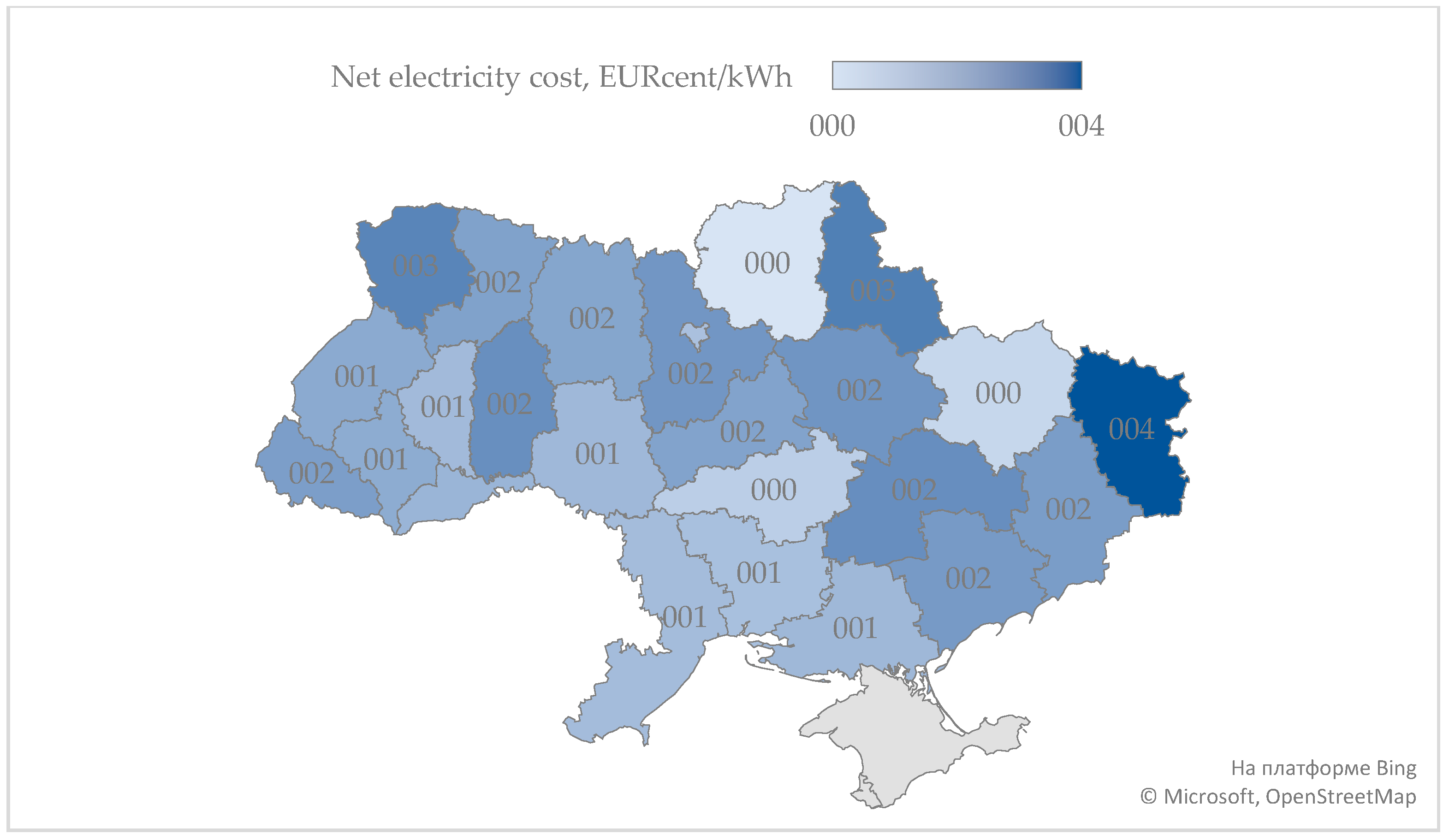
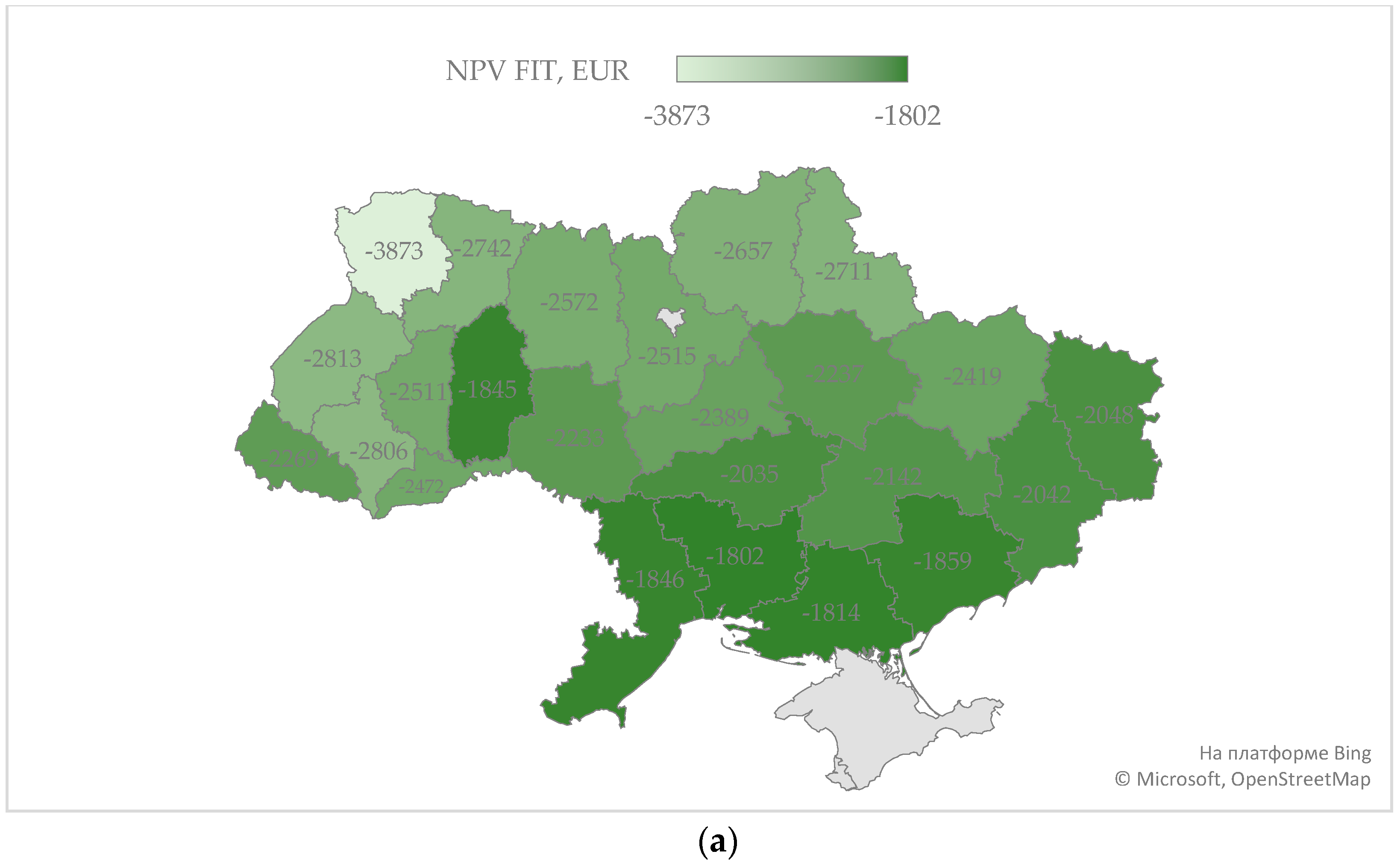
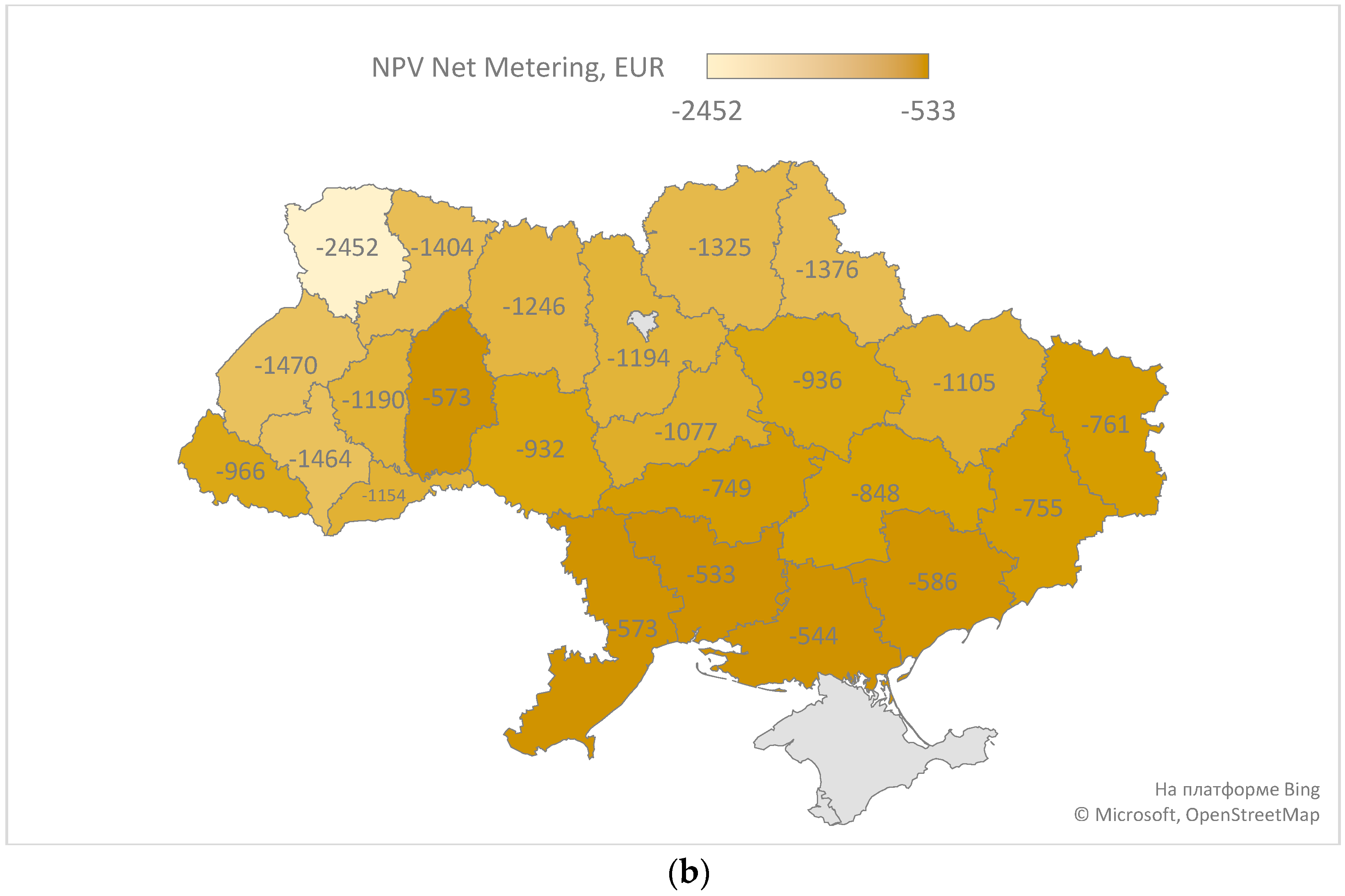
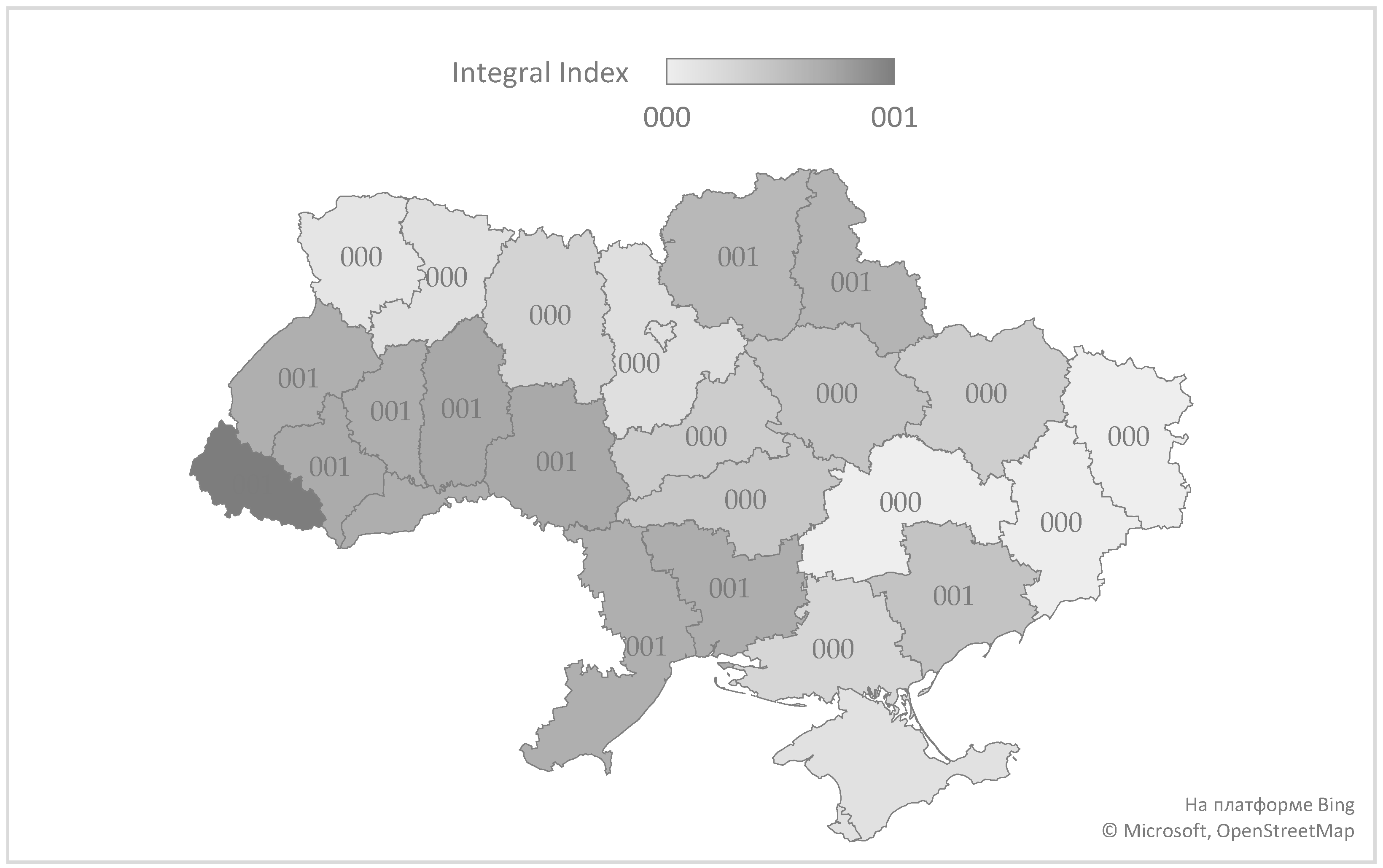
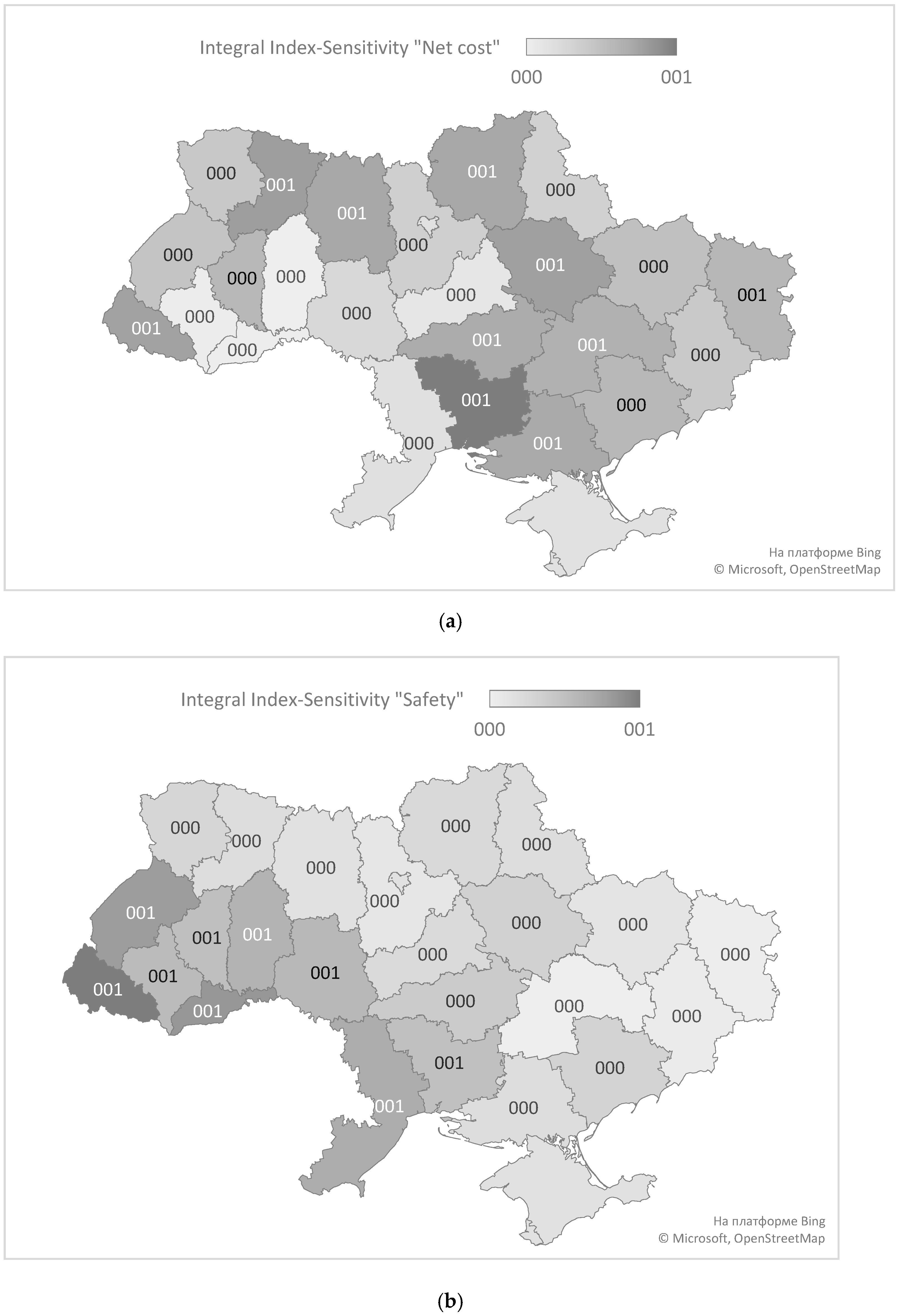
| Barriers | Drivers |
|---|---|
| Low awareness about energy cooperatives | The necessity to decentralize the energy system |
| Unfeasible support schemes | Possibility to (partially) meet energy demand at a lower cost (compared to the individual solutions) |
| Difficulty in reaching an agreement within the group of people due to the general mistrust of cooperative models | The need to ensure one’s own independent energy supply |
| High upfront costs | Help to mobilize private capital [49] |
| Possibility of not worsening air quality [49] |
| Symbol | Description |
|---|---|
| T | Electricity tariff for households |
| NC | Net cost of electricity |
| VAT | Value Added Tax |
| DSOt | Tariff for the services of the DSO |
| TSOt | Tariff for electricity transmission by TSO |
| USPt | Tariff for the Universal Service Provider’s service |
| NPV | Net present value |
| ACFlow | Annual cash flow |
| r | Discount rate |
| i | Number of periods |
| NCi | Net cost of electricity in the i period |
| NCNorm | Net cost of electricity normalized |
| EO | Electricity output |
| EONorm | Electricity output normalized |
| D | Distance from the frontline (proxy for security) |
| DNorm | Distance from the front line normalized |
| II | Integral index |
| wNCi | Weight of the lowest net cost of electricity in the region |
| wEOi | Weight of the electricity output |
| wDi | Weight of distance from the frontline |
| Policy Priority | Criterion Weights | ||
|---|---|---|---|
| Net Cost | Electricity Output | Security | |
| The highest electricity output | 0.5 | 0.25 | 0.25 |
| The highest possible security | 0.2 | 0.3 | 0.5 |
| Indicator | Description |
|---|---|
| Level of energy self-sufficiency | % coverage of the needs of cooperative members |
| Cost per kWh for a member | Comparison to the market price |
| Investment payback period | Years |
| Attracting new members | Annual growth |
| Environmental effect | Reduced CO2 emissions |
| Reliability of supply | Number of failures/outages per year |
Disclaimer/Publisher’s Note: The statements, opinions and data contained in all publications are solely those of the individual author(s) and contributor(s) and not of MDPI and/or the editor(s). MDPI and/or the editor(s) disclaim responsibility for any injury to people or property resulting from any ideas, methods, instructions or products referred to in the content. |
© 2025 by the authors. Licensee MDPI, Basel, Switzerland. This article is an open access article distributed under the terms and conditions of the Creative Commons Attribution (CC BY) license (https://creativecommons.org/licenses/by/4.0/).
Share and Cite
Trypolska, G.; Kubatko, O.; Prokopenko, O. Establishing Solar Energy Cooperatives in Ukraine: Regional Considerations and a Practical Guide. Energies 2025, 18, 3623. https://doi.org/10.3390/en18143623
Trypolska G, Kubatko O, Prokopenko O. Establishing Solar Energy Cooperatives in Ukraine: Regional Considerations and a Practical Guide. Energies. 2025; 18(14):3623. https://doi.org/10.3390/en18143623
Chicago/Turabian StyleTrypolska, Galyna, Oleksandra Kubatko, and Olha Prokopenko. 2025. "Establishing Solar Energy Cooperatives in Ukraine: Regional Considerations and a Practical Guide" Energies 18, no. 14: 3623. https://doi.org/10.3390/en18143623
APA StyleTrypolska, G., Kubatko, O., & Prokopenko, O. (2025). Establishing Solar Energy Cooperatives in Ukraine: Regional Considerations and a Practical Guide. Energies, 18(14), 3623. https://doi.org/10.3390/en18143623








